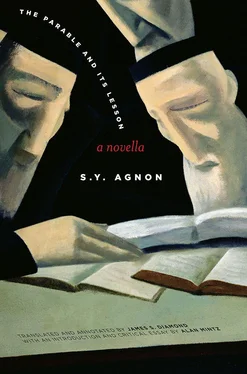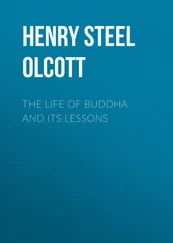I pondered the possibility that the Gehinnom of our time would make us forget the Gehinnom that the shamash saw, and the story about it, and all we can learn from that story. (68)
There is something uncanny as well about the span of time between the two events and the acts of memory that follow them. Between 1648 and the Holocaust is an arc of almost exactly three hundred years. The descent into Gehinnom takes place in the immediate aftermath of the massacres — let us say ten years later — and the shamash’s telling of the story fifty-four years later. Agnon wrote The Parable and Its Lesson in the mid-1950s — it was serialized in Haaretz in 1958—and here we are reading and interpreting it a half century or so later. What is this correspondence meant to tell us? To begin with, it sets up a correspondence between Buczacz in the aftermath of 1648 and Israel, where Agnon is writing the story in the aftermath of the murder of European Jewry. In Buczacz, although the memory of the horrific recent events permeates Jewish life, the community is struggling successfully to reconstitute itself and rehabilitate the institutions of Jewish worship and study. In Israel, although the struggle to make the young state into a secure refuge for the Jewish people is bearing fruit, remembrance of the Holocaust has been pushed to the margins, as has religious culture and practice as well. In this complex analogy, which can be developed in a number of directions, Buczacz emerges as a precursor to Israel, vulnerable to Gentile violence, yes, but autonomous and living under the sway of Torah. 26Israel, in turn, becomes the successor to Buczacz whose mission it is to perpetuate the full and autonomous living of Jewish life without dependence on the gentiles. This is a dialectic that moves forward and backward in time and transcends the received dichotomy between a decaying and moribund diaspora and a Jewish state born of revolutionary Zionism.
A reading of The Parable and Its Lesson in the context of the larger project of A City in Its Fullness shows us the difference between Holocaust literature and Jewish literature provoked by the Holocaust. By their very nature, Holocaust fiction, memoir and testimony, whether in words or video images, focus on the war years and their aftermath. Only in some cases is memory pushed back to the generation of the parents or the grandparents, and then often in the service of shaping a family idyll that is subsequently shattered. For Agnon, the spiritual power of European Jewry, now after its utter eradication, lay farther back in time, much farther than human remembrance can reach. We must therefore rely on the literary imagination and the protean powers of the story, as told in Hebrew, the historical language of the Jewish people, to enter the world that was lost.
NOTES
1. Gershon Shaked, Shmuel Yosef Agnon: A Revolutionary Traditionalist (New York: New York University Press, 1989).
2. Jerusalem: Schocken, 1973. The title is a phrase from the Hebrew Bible, but where it comes from is less simple than meets the eye. The only location where the exact phrase is found is in a stinging prophecy of condemnation against the Northern Kingdom in Amos (6:8): “My Lord swears by Himself: I loathe the Pride of Jacob, and I detest its fortresses. I will declare forfeit city and inhabitants alike [ ‘ir umelo’ah ]” (JPS). The word umelo’ah itself is most familiar from the declarative opening line of Psalm 24, the coronation hymn sung in the synagogue when returning the Torah to the ark on holidays. There umelo’ah occurs in a bound phrase with erets : “The earth is the Lord’s and the fullness thereof” (King James). That bound phrase erets umelo’ah occurs another eight times in Scripture. Since Agnon’s evident purpose in this book is to elevate and sanctify the name of his town, he can hardly mean us to think about the corrupt and condemned city of Amos’ prophecy. By a barely perceptible sleight of hand, Agnon has taken the familiar ecstatic pronouncement about the earth and the fullness thereof and substituted city for earth; all the while we assume — both correctly and mistakenly — that he has simply plucked and transcribed a piece of Scripture. The point of the maneuver is to emphasize that it is a city, his city, that he has come to extol. Whereas the psalm famously declares that the earth and its fullness are the Lord’s, whether the same goes for the city that has been substituted for the earth is not as clear.
3. Quoted in Edward Said, On Late Style: Music and Literature Against the Grain (New York: Vintage, 2006), p. 8.
4. Arnold Band, Nostalgia and Nightmare: A Study in the Fiction of S. Y. Agnon (Berkeley and Los Angeles: University of California Press, 1968), pp. 330–366.
5. Among the most important of these are Beḥanuto shel mar Lublin, ‘Ad henah, Kisui hadam, ‘Ad ‘olam, Eido veEinam , and Hadom vekhise .
6. A select list of critical reactions to the book when it appeared includes Yehudah Friedlander, “Masekhet shivah ufreidah” [Return and Leave Taking], Ha’aretz , June 1, 1973; and “A City and the Fullness Thereof,” Hebrew Book Review (Tel Aviv), Autumn 1973, pp. 3–6; Hillel Barzel, “‘ Ir umelo’ah : ‘uvdah uvedayah” [Ir umeloah: Fact and Invention], Yediyot Aḥaronot , September 26, 1973; Yaakov Rabi, “Hatorah, ha’emunah, vemirmat hatsedaqah” [Torah, Belief, and the Dishonesty of Charity], ‘ Al Hamishmar , October 12, 1973; Yisrael Cohen, “Haḥavayah ha’arkhtipit shel ‘ Ir umelo’ah ” [The Archetypal World of ‘ Ir umelo’ah ], Moznayim , Vol. 28, Nos. 1–2 (Dec. — Jan. 1973–74), pp. 61–73; A. Y. Brawer, “‘ Ir umelo’ah : ‘olam shene‘elam” [‘ Ir umelo’ah : A World That Disappeared], Ha’umah , April 1974, pp. 246–253.
7. Dan Laor, Ḥayyei ‘Agnon [A Life of Agnon] (Jerusalem and Tel Aviv: Schocken, 1998), p. 408.
8. The story began as a fragment, also called “Hasiman,” which appeared in Moznayim (Iyyar/Sivan [May] 1944), p. 104. The full story, with its forty-two sections, appeared in S. Y. Agnon, Ha’eish veha‘eitsim (Jerusalem and Tel Aviv: Schocken, 1962), pp. 283–312. Translated by Arthur Green in Alan Mintz and Anne Golomb Hoffman (eds.), S. Y. Agnon: A Book That Was Lost: Thirty-Five Stories (New Milford, CT: Toby Press, 2008), pp. 397–429.
9. I have argued this point in my Ḥurban: Responses to Catastrophe in Hebrew Literature (Syracuse: Syracuse University Press, 1996).
10. For an expansion of this theses, see chapter 2 (“Two Models in the Study of Holocaust Representation”) in my Popular Culture and the Shaping of Holocaust Memory in America (Seattle: University of Washington Press, 2001).
11. Abyss of Despair ( Yeven metsulah ), trans. Abraham J. Mesch (New York: Bloch, 1950).
12. The narrator as a chronicler allied with the communal register was already employed to great advantage in Hebrew literature by Micha Yosef Berdichevsky. See the story “Parah adumah” in Kitvei Mikhah Yosef Bin-Gurion (Berdichevsky) (Tel Aviv: Dvir, 1975), pp. 181–184.
13. The story originally appeared in Haaretz on September 14, October 5, and December 5, 1958.
14. Literally in the Hebrew: the meat was still between his teeth and undigested. The reference is to Numbers 11:33, which describes the unrestrained cravings of the Israelites for meat. A more contemporary example would be Abraham Joshua Heschel’s celebration of East European Jewish piety in his The Earth Is the Lord’s (New York: H. Schuman, 1950).
Читать дальше












![Edward Ellis - Adrift on the Pacific - A Boys [sic] Story of the Sea and its Perils](/books/753342/edward-ellis-adrift-on-the-pacific-a-boys-sic-s-thumb.webp)